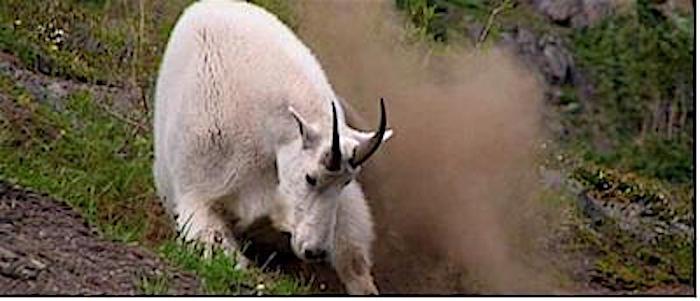
Olympic National Park is conducting its first count of mountain goats in five years/NPS
Before preparing a plan for managing the population of non-native mountain goats in Olympic National Park, wildlife biologists will conduct a population census in the park and adjacent areas of Olympic National Forest in Washington.
Biologists from the U.S. Geological Survey, National Park Service, and Washington Department of Fish and Wildlife will count the mountain goats, which were introduced to the area nearly a century ago, from a low-flying helicopter during the early morning hours of July 12-21, focusing on ice-free areas above 4,500 feet in elevation. The helicopter will operate from a landing area at Obstruction Point. Visitors to that area may experience brief traffic delays when the helicopter is landing and taking off.
“This survey is part of Olympic National Park’s continuing effort to maintain current information about the population of non-native mountain goats,” Superintendent Sarah Creachbaum said in a release. “The data collected during this survey will be invaluable to the park’s mountain goat management plan, which is currently under development.”
Preliminary results of the census will be available in September.
The last mountain goat census was conducted in 2011 and estimated the population to contain about 344 goats in Olympic and adjacent U.S. Forest Service lands, and that the population had increased approximately 5 percent a year since the prior survey in 2004.
The Mount Ellinor area was not counted during the 2011 survey, but this year, with the assistance of the Washington Department of Fish and Wildlife, the entire goat range will be part of the survey effort.
Mountain goats were introduced to the Olympic Mountains in the 1920s, prior to establishment of Olympic National Park. The National Park Service is preparing an environmental impact statement for managing the park’s population. More information about this process is available at the park’s planning website.
Recently, Olympic National park warned visitors to keep their distance from mountain goats. Park regulations state that all visitors must maintain a distance of at least 50 yards, or half the length of a football field, between themselves and any park wildlife. If any animal approaches closer than 50 yards, visitors should move away to maintain the minimum distance.




 Support Essential Coverage of Essential Places
Support Essential Coverage of Essential Places






